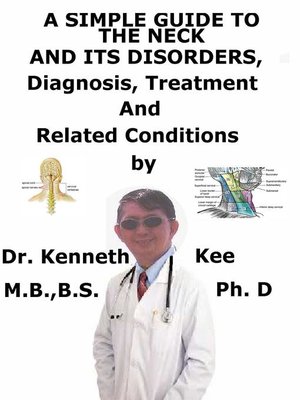A Simple Guide to the Neck and Its Disorders, Diagnosis, Treatment and Related Conditions
ebook
By Kenneth Kee

Sign up to save your library
With an OverDrive account, you can save your favorite libraries for at-a-glance information about availability. Find out more about OverDrive accounts.
Find this title in Libby, the library reading app by OverDrive.



Search for a digital library with this title
Title found at these libraries:
| Library Name | Distance |
|---|---|
| Loading... |
This book describes The Neck and Disorders, Diagnosis and Treatment and Related Diseases
I recently had a patient who had undergone an anterior approach operation to remove 2 slipped disks in his neck which were pressing on the nerves to his left arm causing severe numbness of his left hand and weakness of the arm.
He took 3 months to recover from the operation.
The neck is a very important part of the human body since it attaches the head (and brain) to the trunk of a human.
It can be short or long from wearing necklaces or rings like the Kayan women or it may be retractable like the neck of the turtle to hide the head in the shell.
There are necks that are long like the giraffe or the Kayan Long Neck Tribe women of Thailand and really short necks such as the Klippel-Feil syndrome.
It supports the position of the head and permits the person to turn the head towards stimuli such as a sound from a song or to look sideways at a pretty girl passing by.
It can also look up to see the sky and the stars at night.
It can allow the person to look down to see whether his shoelaces are untied.
The neck is a visible section of the body which is very vulnerable to injuries and trauma.
People had beheaded the heads of persons with a different religion or ideology (the French revolution).
The neck has been stabbed, cut, choked, strangled and hung to kill the owner of the neck by causing loss of blood or air or blockage of blood or air to the brain.
The larynx is part of the neck and attaches the windpipe or trachea to the airways to provide oxygen to the body.
It also functions to prevent food from entering the trachea too.
This is possible since the larynx has a flap on its upper part called the epiglottis that is closed during swallowing and open during breathing.
A person can die if the epiglottis malfunctions and the person chokes on his food.
The larynx can be crushed by strangulation or hanging and the person dies because no oxygen goes to his lungs and brain.
The hyoid bone is the one bone in the body that is not attached to any other bones.
The hyoid bone is attached superiorly to the floor of the oral cavity, inferiorly to the larynx and posteriorly to the pharynx.
The hyoid bone is small, functioning as an attachment point for many muscles affected in swallowing, jaw movements, and respiration.
The breathing can be affected if the hyoid bone is damaged.
Arteries which supply the neck are common carotid arteries which carry oxygen to the brain.
If these vessels are blocked by a blood clot or injury, there is loss of oxygenated blood to the brain causing a stroke or coma.
Sensation to the front regions of the neck derives from the roots of the spinal nerves C2-C4, and at the back of the neck from the roots of C4-C5.
Any injury to the neck such as whiplash injury or herniated vertebral disk can cause numbness or weakness of the arm and hands.
The vagus nerve or 10th cranial nerve travels down the neck.
The vagus nerve helps to regulate many vital parts of human body, such as the heart rate, blood pressure, sweating, digestion, and even speech.
Sudden stimulation of a vagus nerve can produce what is called a "vasovagal reflex," which consists of a sudden drop in blood pressure and a slowed heart rate.
The heart may even stop and the person may die.
The spinal cord is present in the spinal canal of the neck vertebrae.
Any injury of the spinal can cause complete paralysis of the body from the neck downwards causing quadriplegia as happened to the Christopher Reeves (the Superman actor) when he broke his neck...







